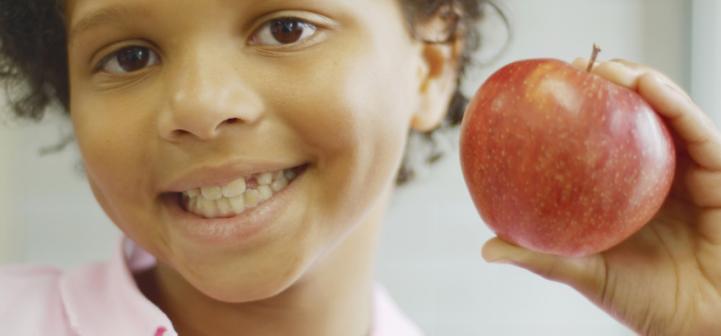
Each year on October 24th, Food Day is celebrated nationwide with a goal of helping people learn to “eat real.” The event, created by the Center for Science in the Public Interest, aims to give individuals the encouragement and knowledge needed to maintain healthier diets and support more sustainable food systems. Among the many free resources and tools for participating in the event is a curriculum designed for upper elementary and middle school students. It consists of 5 healthy eating lessons that were developed in 2014 by Pamela Koch, EdD, RD and Isobel Contento, PhD, CDN, of Teachers College Columbia University, Laurie M. Tisch of the Center for Food, Education & Policy.
Lesson 1, Eat Real, aims to teach students the difference between whole and processed foods and why eating more whole foods is healthier. The lesson includes photographs of whole foods and bar graphs showing students how much the foods are processed and how processing changes the healthfulness of the food. Finally, the lesson guides students through making an Eat Real Action Plan.
Lesson 2, Mostly Plants, is designed to increase students’ understanding of the importance of maintaining a plant rich diet in which ¾ of meals are whole and plant based. This lesson also includes images of plants that are commonly eaten such as carrots, tomatoes, lettuce and even sunflower seeds. It concludes with a guided meal reflection and planning activity using MyPlate’s popular graphic.
Lesson 3, Not Too Much, focuses on portions and why it’s important to limit intake of fat, sugar and salt. This lesson includes a hands on experiment that helps students to visualize intake using play dough and a Small Size-it Action Plant for reducing consumption of overly processed foods.
Lesson 4, Navigate the Environment, aims to lead students in discovering their own food environments and how those environments can support healthy food goals. The lesson ends with a Seeking Out Real Food Action Plan that guides students to identify ways that they can make healthier food choices in their own food environments.
Lesson 5, Be an Advocate, provides guidelines and steps for creating and implementing a plan to make positive change to food environments at school, at home and in the community.
Each lesson is designed to take about 45 minutes. It is recommended that the lessons are taught in sequence during the week of Food Day, however, they are relevant year round and each lesson can stand alone! Each lesson also includes a list of related activities and resources that can extend the lesson including readings, films, games and additional lessons. The lessons can also be adapted for younger and older students and are recommended for integration into science classes. They also can be used to meet Common Core Standards in English Language Arts & Literacy, History/Social Studies, Science and technical subjects.
Impact & Outcome
In a preliminary evaluation, 48 students were interviewed after receiving the curriculum. Most students had good to excellent understanding of the main behavioral messages of Eat Real (96%), Mostly Plants (92%) and Small Size It (74%). Students also give examples of how to make changes in their lives, “I asked my father to buy vegetables at the supermarket. He made a surprise for me, meat with vegetables in it.” — Gabe. “When my dad buys me a bag of chips, I eat a little bit and save for [the] next day for school snack. — Gloria.
Download the curriculum here: Food Day School Curriculum
For more ideas for getting involved in Food Day in your school, start here: One-pager: Food Day in Schools
Contributors
Katie Baildon, Cornell Center for Behavioral Economics in Child Nutrition Programs
Pam Koch, EdD, RD, Teachers College, Columbia University
Sources
Abstract on evaluation: Porter, K, Koch P, Kotek R, Hays M, Contento I. Evaluation of the Food Day School Curriculum to Teach Children Why and How to EAT REAL. Journal of Nutrition Education and Behavior. Volume 44, Issue 4, Supplement, Page S71, 2012 DOI: http://dx.doi.org/10.1016/j.jneb.2012.03.166

